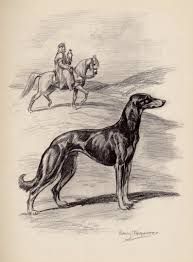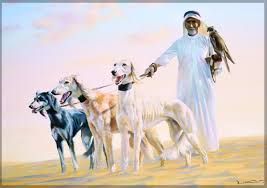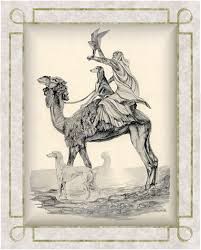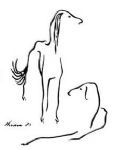Breed History



History of Saluki
The Saluki, also known as the Gazelle Hound or Persian Greyhound, was once considered the “Royal dog of Egypt.” They have been regarded as the oldest known breed of domestic dog. The Saluki's history is rich and dates back some 9000 years. They have remained the same today as they were in ancient times. To the desert Arabs, they are known as “El Hor-The Nobel One” and are held in very high regard. Never being sold they were rarely given as gifts and only to those who were deemed truly worthy.
The distribution of the saluki can only be credited to the nomadic desert Arabs, known as Bedouin, which traveled the desert as a means of livelihood. Still today this tradition remains. These nomadic caravans are said to have introduced the Saluki to Egypt for trading purposes. They would exchange their beloved hounds for copper, turquoise, and myrrh. Remains of relics, mummified Salukis, paintings and sculptures were often found in tombs.
The Bedouin’s bred the Saluki in the likeness of the mighty Arabian horse. Grace, speed, endurance and beauty were never compromised and to this day are still the most prominent characteristics of both species. They are clean-cut with silky hair, deep chests and long legs.
Salukis are considered holy and often revered as “a sacred gift of Allah”. The Bedouin’s believe that the “Saluki is the hound of Allah; and must therefore be perfect.” Because the saluki was considered holy they were allowed to live among the tribe in the tents. No other dog or creature was even allowed this privilege.
Salukis are known as sighthounds or gazehounds meaning they hunt by sight and speed. The Bedouin’s bred the Saluki to hunt down small animals such as the hare or fox, as well as large game like the desert gazelle.
In the beginning of the hunt, the hound was carried on horse or camelback to maintain is strength for the impending chase. Sometimes a hawk and a saluki were used together to hunt. The hawks were trained to sight the target and strike the prey to slow it down or to circle around it at close range. Once a target was determined, the hunter would release the Salukis. Their primary objective was to race toward the hawks, identify and capture its prey. The best-trained Saluki’s though could find and take the prey down without the assistance of the hawk. The chase could be short and fast or could last for miles. Thus the Bedouin bred the Saluki to possess great stamina and speed.
The Saluki was bred to withstand the roughest of environments. Native hounds get no pampering and live hard. The have firm partially webbed feet with hair between the toes for protection. This enables them to run over rough terrain at great distances without injuring their pads.
Adult Salukis should appear solid with well-defined muscle. Their coats should be shiny and the first two or three ribs should be visible. The high loin bones are a feature to the breed that should also be seen. They are sleek and long-legged with an elongated narrow face and bright almond shaped eyes.
The Saluki is an athletic dog and is slim and fine-boned. There are two types of coat, smooth and feathered. The feathered variety has long hair on the ears, tail and legs. A Saluki can vary in size depending on its bloodline and region of origin but the standard for a male is between 50-60 lbs and for a female 35-55 lbs. Any color variation or combination is accepted. Grizzles, black and tan, white, cream, fawn, and red are just a few.
Saluki are generally quiet natured and will usually bark only to give warning to a stranger. They make great companions and are completely devoted to their family. They tend to be aloof to strangers, as the Bedouin bred this characteristic into them.
A lot of patience and understanding in needed to teach Salukis what is expected. Obedience is important and should be started as a young puppy. They should be treated in a gentle manner, and should be praised with the correct response. If treated harshly they can become timid and nervous.
Salukis are slow maturing both mentally and physically. On average they will reach their maturity at around three years of age. As adult they have small appetites and don’t eat much. Because of their long legs it is a good idea to feed them from a bowl raised from the ground. They have no doggy smell and require little grooming. It is extremely important to brush the feathering on the ears to keep from matting.
The Saluki is not for everyone. They require a lot of daily exercise. They prefer free runs off lead, but if this is not possible they should be walked at least two miles daily. When exercising off lead it is important to do so in a safe and secured area. Due to their natural instincts, if they see something interesting and run off you may have a hard time retrieving them. A Saluki that is kept in good condition will enjoy a long, happy, healthy life.
Salukis are active, alert, affectionate, elegant, graceful, gentle, intelligent, independent, aloof to strangers and can be quite sensitive. The Saluki is an all-purpose hound designed for speed, a strong desire to hunt, an unsurpassed loyalty to its owner and yes, even obedience.
Taken from Royalesaluki.com
Contact Details
The Club SecretarySydney, NSW, Australia
Phone : 0419484914
Email : [email protected]
